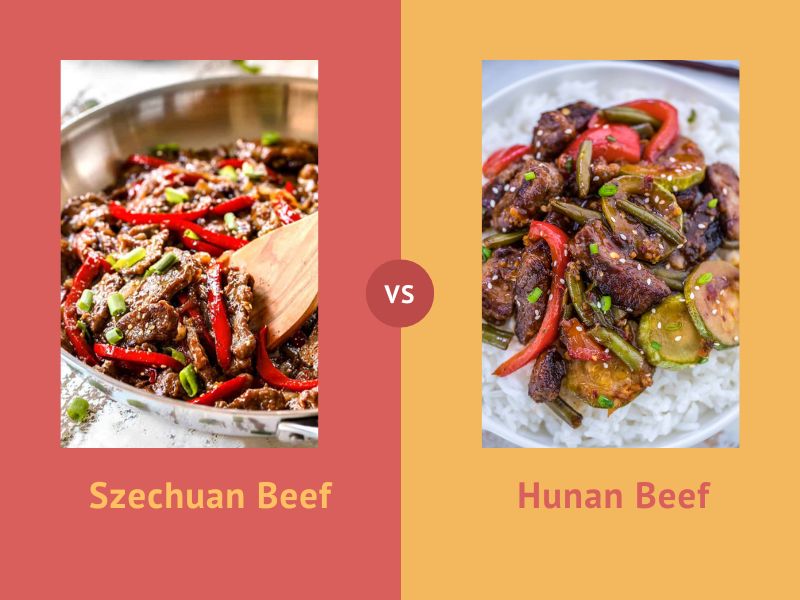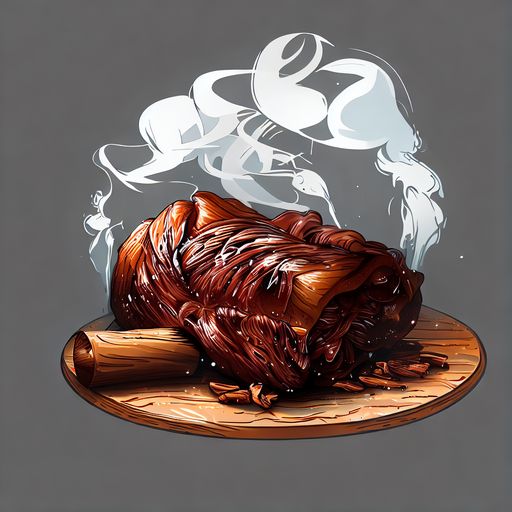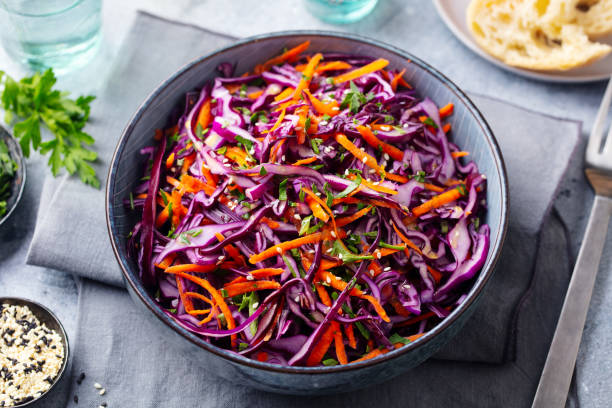Hunan Beef Vs Szechuan Beef: What Is The Main Difference?
China boasts a rich culinary heritage, with various regions offering distinct beef recipes. Among these, the Szechuan and Hunan provinces are renowned for their famous beef dishes. Unfortunately, many people are unaware of the notable differences between these two styles of cooking.
Both Szechuan and Hunan beef dishes are gaining popularity in various dining settings, making it all the more important to understand their unique characteristics and preparation techniques. Despite their outward similarities, these culinary delights differ significantly in taste and flavor profiles.
So, what is the difference between hunan beef vs szechuan beef? The key lies in their respective seasonings. Szechuan beef relies on the distinctive flavor of Szechuan peppercorns, which impart a numbing and fiery sensation. On the other hand, Hunan beef derives its taste from the inclusion of spicy chili peppers, be it fresh or pickled. Additionally, variations in marinades and other ingredients contribute to further differences between the two styles.
In this comprehensive exploration, we delve into the components, preparation methods, and final results of both Szechuan beef and Hunan beef. By delving into the intricacies of these culinary traditions, you will gain the knowledge necessary to make an informed decision when faced with the choice between the two delectable dishes.
What Is Szechuan Beef?
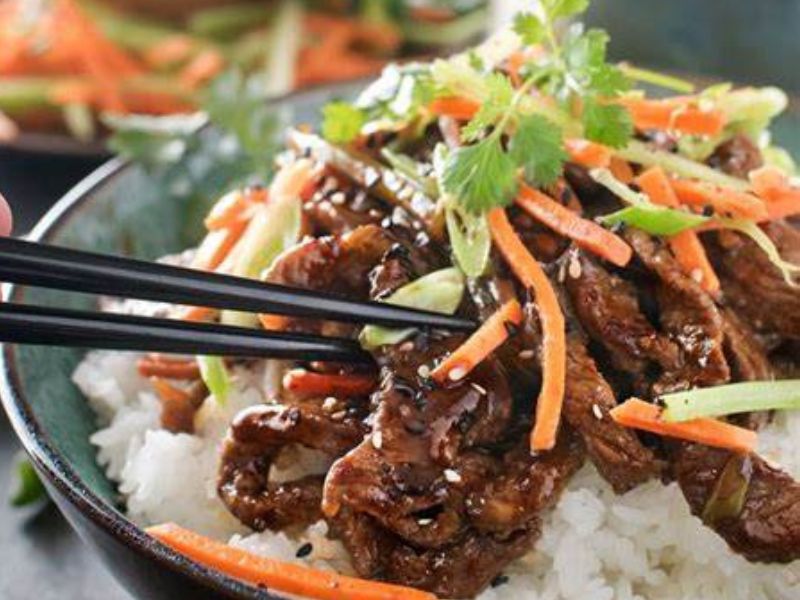
Szechuan cuisine, also referred to as Szechwan cuisine, is widely recognized as a distinct style within Chinese culinary traditions. Its defining characteristic is the use of Szechuan peppercorns, which are indigenous to the region and impart a unique flavor profile to dishes like Szechuan beef.
While Szechuan beef possesses a remarkable taste, it often remains overshadowed by the more intricate and elaborate specialties found in Sichuan cuisine.
The culinary landscape of Szechuan cooking is defined by its penchant for spiciness and pungency. Generous amounts of garlic and hot peppers are frequently employed, resulting in an explosion of flavors.
To prepare Szechuan beef, marinated beef strips are skillfully stir-fried with garlic, chile, Szechuan peppercorns, onions, almonds, and water chestnuts, forming a harmonious medley of textures and tastes.
While additional vegetables like carrots, zucchini, or broccoli can be incorporated to enhance the dish, the aforementioned components constitute the quintessential elements of Szechuan beef preparations.
Complementing the robust flavors of this stir-fry, options such as brown rice are often offered due to its higher nutritional content. In Western cuisine, it is not uncommon to pair Szechuan beef with noodles, sticky white rice, or sautéed greens, providing a diverse array of accompaniments to suit different palates.
Unique Ingredients in Szechuan Beef Preparation
The process of making Szechuan beef involves several essential components that contribute to its distinct flavor profile. At the core of this dish lies the marinade, which serves as the primary source of flavor. Additionally, the beef strips play a crucial role, and the inclusion of various vegetables and herbs adds a final touch of vibrancy.
While the specific ingredients used in each element may vary to some extent, there are certain key elements that should never be overlooked. Omitting these spices would result in a dish that falls short of being authentic Szechuan beef.
Beef Preparation
The initial step involves preparing the meat for cooking. When it comes to stir-frying, our preferred choices of beef are flank steak and top sirloin steak. It is important to slice the meat into thin strips and then incorporate them into the marinade.
Marinade Mixture
To create an exceptional marinade, a combination of soy sauce, Szechuan peppercorns, minced or smashed garlic, red pepper flakes, and cornstarch should be included. These ingredients work in harmony, resulting in beef strips that are tender, packed with umami flavors, and infused with a delightful spiciness.
The addition of rice wine or general cooking wine is a common practice. Furthermore, skilled chefs and cooks often introduce ingredients like sugar, ginger, and sea salt to enhance the depth and complexity of the marinade.
While the marinade’s ingredient list may have some variability, the constant elements are soy sauce, Szechuan peppercorns, garlic, red pepper, and cornstarch. These core ingredients provide the foundation for the marinade’s distinctive character.
Complementary Components
Once the marinated beef strips have been cooked, additional ingredients can be incorporated. Popular choices include broccoli, water chestnuts, and roasted peanuts. Some variations may include baby corn, pea pods, and a touch of ginger for added dimension.
It’s worth noting that Szechuan beef recipes typically emphasize simplicity in the ingredient selection. The secret to achieving the exquisite taste of this dish lies not in an abundance of ingredients but rather in the careful selection and skillful utilization of the chosen elements.
Significance of Ground Sichuan Peppercorns
At this point, you may wonder about the role of Szechuan peppercorns in the overall preparation. These unique peppercorns play a vital role in every stage of the cooking process.
Both the marinade and the stir-fry itself incorporate Szechuan peppercorns, allowing their distinct flavor to infuse the dish. Additionally, sauces accompanying Szechuan beef can benefit from an extra sprinkle of these peppercorns.
It is important to remember that Szechuan peppercorns are the primary source of heat in this meal. Compared to other classic Szechuan dishes, the amount of chili added is relatively modest. The focus is on the intense numbing and citrusy flavor provided by the Szechuan peppercorns rather than overwhelming spiciness.
How To Make Szechuan Beef
Preparing a mouthwatering Szechuan Beef dish requires minimal effort, allowing you to enjoy the delicious flavors without much hassle. The first step is to create a flavorful marinade, which can be easily prepared by whisking together the necessary components until a smooth consistency is achieved.
Next, place the marinade and the beef strips in a sealable plastic bag and give it a good shake, ensuring that the marinade is evenly distributed. Allow the meat to marinate for at least 20 minutes, allowing the flavors to penetrate the beef and enhance its taste.
Once marinated, remove the beef strips from the marinade and swiftly cook them in a wok over high heat. This quick cooking method ensures that the beef retains its tenderness while developing a delicious sear. The marinade can also be utilized to create a delectable Szechuan sauce, further enhancing the overall flavor profile of the dish.
After a few minutes of cooking the beef strips, it’s time to incorporate any additional fixings, with vegetables taking the lead. Toss them in the wok and cook them briefly, ensuring they are cooked but still maintain their delightful crunchiness.
To add the finishing touches, roast some peanuts separately until they achieve a perfect crunch. Once ready, you can toss in any leafy greens or herbs, infusing the dish with their vibrant flavors. This is the opportune moment to taste the dish and make any necessary seasoning adjustments to achieve the desired balance of flavors.
Taste
When prepared correctly, Szechuan beef is an absolute delight for your taste buds, offering a perfect combination of umami, sweetness, saltiness, and a hint of bitterness or sourness. The inclusion of sugar in the recipe contributes to its notable sweetness, beautifully counterbalancing the saltiness and spiciness imparted by Szechuan peppercorns, soy sauce, and red pepper flakes.
While this beef stir-fry may not reach the fiery heat levels of some other dishes in Szechuan cuisine, it remains an easily mastered recipe with its own distinct brand of heat. The unique characteristic of Szechuan peppercorns is their ability to not only create a tingling sensation but also impart a numbing effect, adding a captivating element to the dish. Furthermore, these peppercorns infuse a subtle lemony flavor into the meal, adding a delightful twist to the overall taste experience.
Texture
One of the appealing aspects of this dish is the array of textures it offers, with each ingredient contributing to a harmonious blend. The beef strips should be tender and smooth, ensuring a melt-in-your-mouth experience with every bite. In contrast, any additional vegetables should be flash-fried to retain their crunchiness while still being cooked to perfection. The leafy greens undergo a similar process, becoming tender and succulent, providing a pleasing contrast to the other ingredients.
For those seeking an added crunch, incorporating whole peppercorns or toasted peanuts at the end of the cooking process will elevate the texture of the dish, adding an exciting element to each mouthful.
What Is Hunan Beef?
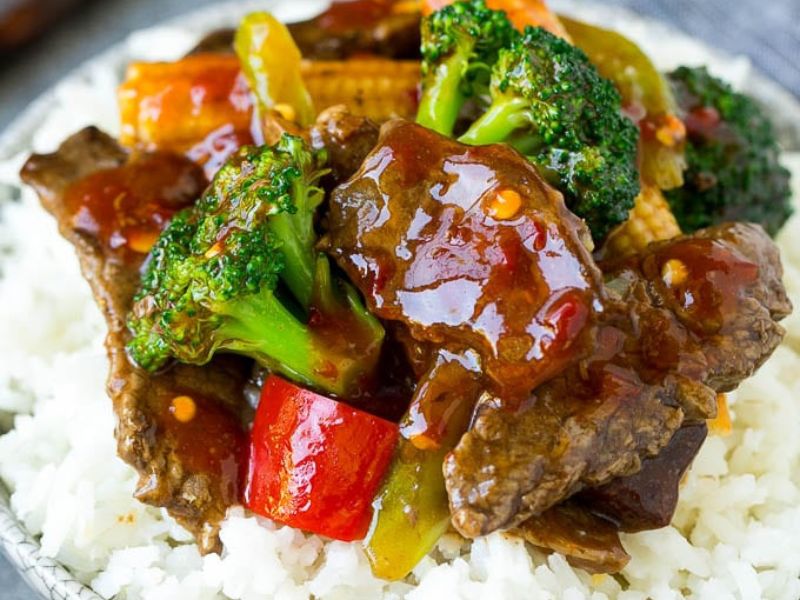
Prepare a delectable Hunan-style beef stir-fry, influenced by the culinary traditions of the eastern Chinese province. This cuisine shares several key characteristics with Szechuan food, characterized by a penchant for spiciness that infuses almost every dish.
One distinguishing feature of Hunan cuisine is the use of smoked meats, which impart a unique and rich flavor to the meals. Additionally, Hunan chefs are known for their skillful utilization of fresh aromatic ingredients and vibrant, colorful components, resulting in visually appealing and fragrant dishes.
Finding an authentic Hunan beef dish can be challenging in today’s culinary landscape. Many restaurants opt for expedience and cost-efficiency, compromising on the true essence of traditional recipes. However, it’s worth noting that authentic Hunan beef recipes possess a remarkable depth of flavor and require the use of specific ingredients to achieve the desired taste.
For an authentic Hunan meat experience, seek out dry, smoked beef, akin to beef jerky but with an even more pronounced flavor profile. The inclusion of a wide variety of chili peppers, both fresh and dried, is a hallmark of this cuisine. Whether eaten fresh, dried, or pickled, these peppers intensify the heat in the dish without numbing the palate, allowing the spicy sensation to be experienced fully while still maintaining a balance of flavors.
Hunan beef recipes exhibit a delightful diversity in their ingredients. Commonly featured elements include garlic, ginger, fermented black beans, and various smoking and curing techniques. However, the choice of greens and vegetables to include in the dish is a matter of personal preference, offering an opportunity for culinary creativity.
It is important to note that Hunan beef is traditionally served without any marinade or sauce. The moisture in this dish is derived solely from the succulent beef and luscious vegetables, resulting in what can be described as a “dry stir-fry.” To complement this flavorful dish, one can opt for a serving of brown rice or thick noodles. Alternatively, many individuals savor the Hunan beef on its own, accompanied by a refreshing glass of beer or a traditional Chinese wine.
Unique Ingredients in Hunan Beef Preparation
To achieve the incredible flavor of Hunan beef, only a few ingredients are needed: garlic, ginger, and an abundance of chili peppers. However, let’s delve deeper into the constituent components of this mouthwatering dish.
Beef
At the heart of Hunan beef lies dry, smoked beef strips. These strips, although sometimes challenging to find, contribute a distinct smoky essence that cannot be replicated easily. While beef jerky can be a decent substitute, it lacks the desired smokiness.
To cut costs, some restaurants take matters into their own hands by drying and smoking their meat in-house. While this may not be feasible for most individuals, you can explore Asian supermarkets or butcher shops to find a suitable alternative.
If you cannot find a suitable substitute, fresh meat can be used. The best cuts of beef for Hunan beef are obtained from the flank. This particular cut strikes a delicate balance, being both tender and juicy while still being firm enough to slice thinly.
To achieve the desired texture and crispness, these paper-thin slices of fresh beef are pan-fried over high heat, allowing them to dry up and become delightfully crisp.
Marinade
Let’s discuss the marinade that imparts rich and distinctive flavors to Hunan beef. While we will delve into the topic of chilies shortly, it is important to note that garlic, ginger, and celery are the primary aromatic elements in the marinade. Celery not only provides a pleasant texture but also contributes to the overall flavor profile, while the other ingredients add layers of complexity to the dish.
The marinade is created by combining these aromatic elements with a liquid base. Light or dark soy sauce, oyster sauce, rice wine, or a Chinese marinade can serve as the foundation for this delectable dish. Given that the condiments and smoked dried beef (if used) already provide sufficient saltiness, there is no need to add any additional salt to the marinade.
In contrast to Szechuan beef, Hunan beef does not require the addition of sugar to balance the salty and spicy flavors.
Chilies
One characteristic that defines Hunan beef is its fiery spiciness. Fresh, dried, or pickled chilies can be used, and there is no definitive “correct” type to choose.
Restaurants often opt for pickled or fresh chilies due to their texture and moisture content, which enhance the overall experience of the dish.
For pickled chilies, the most authentic varieties are those originating from China, infused with flavorful herbs and spices.
Since Hunan beef is cooked without the marinade, dried chilies won’t contribute to the juiciness of the dish; instead, it becomes crucial to incorporate other juicy components.
Complementary Elements
Hunan beef can be prepared with or without the marinade, and various side dishes can be added to complement the main flavors. To maintain their crispness, these additional ingredients are typically quickly stir-fried or flash-fried.
The essential elements of Hunan beef include onions and fermented black beans, but beyond that, the dish is highly adaptable to personal preferences and creativity.
Carrots and bell peppers are popular additions, with carrots providing vibrant color and bell peppers introducing a delightful crunch. Another variation of Hunan beef often features sautéed broccoli, along with spring onions and sesame seeds.
With this comprehensive understanding of the ingredients involved in Hunan beef, you can now embark on your culinary adventure to create a tantalizing and authentic dish that captures the essence of this beloved Chinese cuisine.
How To Make Hunan Beef
The preparation methods for Hunan beef can vary significantly depending on the quality of the meat being used. The approach taken to prepare the dish will differ based on the specific characteristics of the meat.
When working with dried and smoked meat, there is no need to marinate it. The flavors have already been enhanced through the drying and smoking process.
However, if you desire the dried strips to have a more pronounced taste, you can choose to soak them in a flavorful liquid for approximately 20 minutes. Additionally, you may opt to cook the dried strips with a small amount of Hunan sauce to further enhance the flavor.
For fresher meat, a longer marinating time is required. To marinate thinly sliced beef, you can place it in a Ziploc bag along with the marinade and refrigerate it for approximately 2 hours.
When it’s time to cook the marinated beef, remove it from the marinade and discard any excess liquid. It is important not to include any of the liquid in the cooking process.
Towards the end of the cooking time, add the chili peppers and any other supplementary seasonings. Greens and herbs are typically incorporated during the final stages of cooking to preserve their freshness.
Taste-wise, Hunan beef is known for its spiciness, which can vary depending on the type and quantity of chili peppers used. Unlike Szechuan peppercorns, Hunan beef does not have a numbing effect but rather delivers a pure, intense heat.
The flavor profile of Hunan beef is dominated by umami and salty notes. If fermented black beans are included, an earthy and slightly sour flavor is also present, contributing to an authentic recipe. The inclusion of vegetables in Hunan beef adds an earthy and somewhat sweet dimension to the overall taste.
In terms of texture, Hunan beef is considered a “dry” stir-fry since it doesn’t utilize a sauce during the cooking process. As a result, the dish has a drier texture compared to traditional stir-fries. However, this doesn’t mean it lacks moisture entirely.
Hunan beef features marinated beef that is juicy, tender, and paired with crisp vegetables. Fresh or pickled chili peppers can be used to create a sauce for cooking the meat and vegetables together.
While sesame seeds provide a subtle crunch to the dish, their texture is not as pronounced as that of larger seeds or nuts commonly used in other recipes.
Szechuan Beef Vs Hunan Beef —Similarities And Differences
Szechuan beef and Hunan beef share certain similarities, but they also possess distinct characteristics that set them apart.
Ingredients
Firstly, let’s delve into the choice of meat used in these dishes. Szechuan beef typically utilizes fresh meat, while Hunan beef often features dry smoked beef strips. However, if dry smoked beef strips are not available, freshly sliced beef can serve as a suitable alternative.
Both recipes employ a marinade, although the marinade recipes differ significantly. Szechuan beef derives its distinctive flavor from marinating the beef in a mixture of soy sauce, Szechuan peppers, red pepper flakes, garlic, and cornstarch. On the other hand, the base of a Hunan marinade consists of garlic, ginger, chili peppers, celery, and various salty Chinese sauces.
Once marinated, the meat is removed from the marinade and fried. In the case of Szechuan beef, the marinade is incorporated into the stir-fry, intensifying the flavors. Conversely, for Hunan beef, the marinade is generally discarded and not included in the recipe, although some variations may utilize it.
Moving on to the aromatic components of the stir-fry, Szechuan beef typically incorporates vegetables such as baby corn, pea pods, broccoli, Szechuan peppercorns, and additional salt and sugar to achieve a well-balanced flavor profile. Other commonly added ingredients include water chestnut, toasted peanuts, and sliced ginger.
In contrast, Hunan beef includes a broader selection of vegetables such as red and yellow bell peppers, carrots, onions, and broccoli. Chopped chilies, whether fresh, pickled, or dried, are also extensively used in Hunan cuisine.
Flavor
Regarding flavor, Szechuan beef tends to be sweeter and less spicy compared to Hunan beef, primarily due to the presence of extra sugar. The distinctive Szechuan peppercorns used in this dish provide a numbingly hot taste, while the chilies employed in Hunan beef impart a fiery and piquant flavor.
The greater variety of vegetables in Hunan beef leads to more nuanced tastes. The versatility of the recipe allows for the use of marinades that infuse the meat with deeper and more complex flavors.
Texture
In terms of texture, when prepared with its marinade or a homemade Szechuan sauce, Szechuan beef tends to be more juicy than Hunan beef. The tenderness of the meat and vegetables contributes to the overall moisture of the dish. Additionally, the inclusion of roasted peanuts provides a delightful nutty crunch to complement the tender Szechuan beef.
On the other hand, dryness is less of a concern with Hunan beef. As the meat and vegetables are cooked together, they provide sufficient moisture, resulting in a texture that is less dry compared to Szechuan beef. This variation in texture also contributes to the overall taste experience.
In conclusion, while Szechuan beef and Hunan beef share similarities such as being stir-fries made with marinated beef and a spicy kick, their differences lie in the choice of meat, marinade recipes, vegetable selection, flavor profiles, and texture. Understanding these distinctions allows for a greater appreciation of the unique culinary experiences offered by these two beloved Chinese dishes.
Conclusion
Hunan Beef and Szechuan Beef are two remarkable culinary creations that have seemingly developed independently but share a common thread. These dishes showcase the rich diversity and bold flavors of Chinese cuisine, each with its unique characteristics that set them apart.
The difference between Hunan Beef and Szechuan Beef lies primarily in their visual presentation and the level of spiciness they offer. Hunan Beef boasts a vibrant and enticing color palette, while Szechuan Beef captivates with its fiery and intense heat. Both dishes exemplify the essence of Chinese culinary excellence by delivering robust and unforgettable flavors.
For those new to Chinese cuisine or seeking a milder experience, Hunan Beef is an excellent choice. Its harmonious blend of flavors, complemented by a visually appealing presentation, makes it an ideal starting point. The dish offers a gateway into the realm of Chinese cuisine, allowing beginners to savor the distinctive tastes while gradually building their spice tolerance.
On the other hand, for seasoned Chinese culinary enthusiasts who relish a more exhilarating dining experience, Szechuan Beef is a superb option. With its pronounced heat and bold flavor profile, this dish challenges the palate and rewards those who appreciate culinary intensity. Szechuan Beef exemplifies the complexity and depth of flavors that Chinese cuisine can achieve, making it a delightful adventure for seasoned connoisseurs.
Both Hunan Beef and Szechuan Beef embody the essence of Chinese culinary artistry, offering distinct characteristics that cater to different preferences. By embracing the opportunity to explore these dishes, you embark on a journey of gastronomic delight, expanding your appreciation for the vast and vibrant world of Chinese cuisine.
